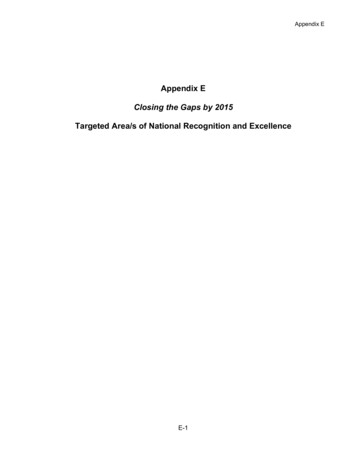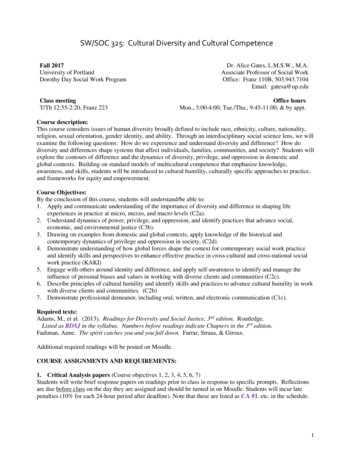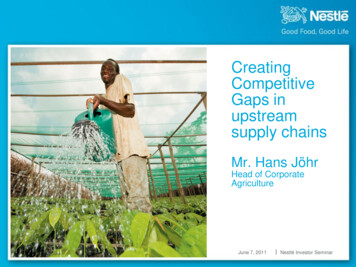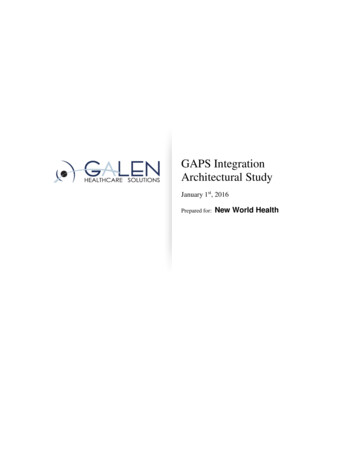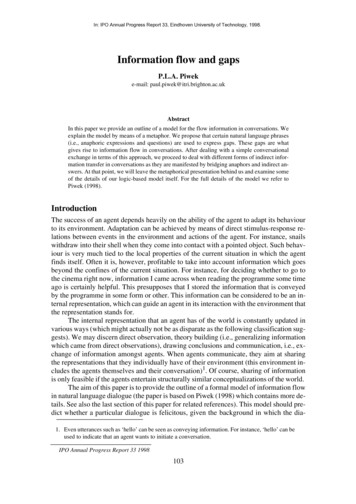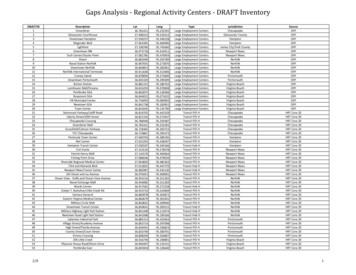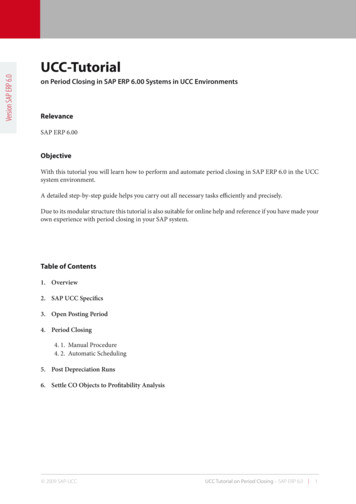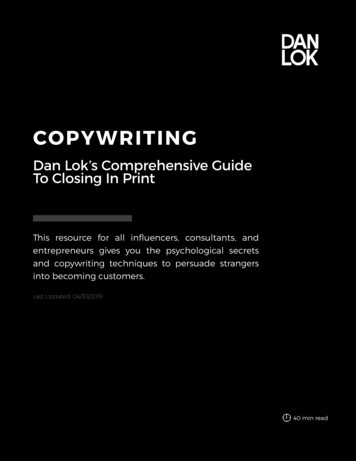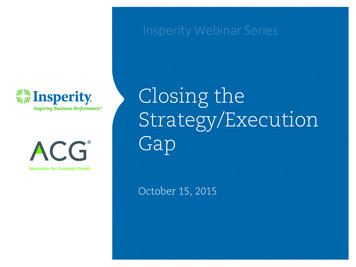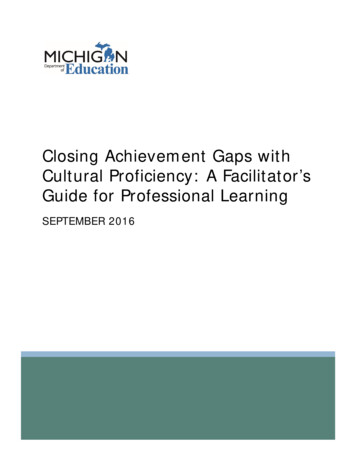
Transcription
Closing Achievement Gaps withCultural Proficiency: A Facilitator’sGuide for Professional LearningSEPTEMBER 2016
Michigan Department of EducationContentsOverview .2Purpose and Background.3Work Session Goals .6Intended Audiences .6This Guide .6Using this Facilitator’s Guide .7Materials .7Preparation for Work Session Activities .8Section Scripts and PowerPoint Links .8Lessons Learned .8Contributors .9Closing Achievement Gaps with Cultural Competency: Facilitator’s Guide1
Michigan Department of EducationOverviewThe Michigan Department of Education (MDE) created Closing Achievement Gaps withCultural Proficiency as a culmination of the three-year African American Young Men ofPromise Initiative (AAYMPI). The professional learning activities use best practices and theexperiences from years one and two of AAYMPI to build cultural proficiency with twoactionable, effective, and research-based techniques: academic vocabulary andpositive phone calls home. These components were used as the premise to bringawareness of cultural proficiency to Michigan educators.The materials contained in the lessons are from workshops, professional presentations,and training sessions and are designed for implementation into a single work session orover multiple sessions. The intent of the lessons is to enhance educators’, policymakers’,and state education agencies’ (SEAs) knowledge of cultural proficiency as a means toeliminate achievement gaps as well as incorporate the professional learning into existingprograms and initiatives.The lessons contained are fully adaptable and are arranged as discrete sections in order toprovide natural breaking points. Altogether, the sessions should take about six hours, tocomplete. However, the learning would also be effective across multiple sessions. It isencouraged that administrators, SEAs, or school staff members modify the learning tobest serve the needs and time commitment of the staff, school community, or district.TermsAcademic Vocabulary: Vocabulary instruction designed to build rich and flexible wordknowledge. The Michigan state academic standards for English Language Arts defineacademic vocabulary as words that are “Tier 2”, found across many types of texts andhighly generalizable.Cultural Proficiency: A framework that promotes and affirms a diversity of perspectives,recognizing that everyone belongs to multiple demographic and cultural backgrounds,including, but not limited to, race/ethnicity, religion, socio-economic status, and sexuality.Positive Phone Calls Home: An intervention whereby educators can foster student’sacademic growth and personal self-esteem by creating relationships withparents/families/guardians to share student successes and efforts. It should be notedthat not all contact is expected via phone calls; other types of media engagement areencouraged.Closing Achievement Gaps with Cultural Competency: Facilitator’s Guide2
Michigan Department of EducationPurpose and BackgroundClosing Achievement GapsAn achievement gap is a “discrepancy in educational outcomes and access betweenvarious student groups in the United States, in particular, African-American, NativeAmerican, certain Asian-American, and Latino students on the low end of the performancescale, and their White and certain Asian-American counterparts at the higher end of theacademic performance scale” (Howard, 2010). While the term achievement gap oftenrefers to disparities in academic performance among various student groups, the primaryfocus of many studies remains on the existing disparities between African-American andWhite students.According to Howard (2010), closing achievement gaps could help reduce both economicinequality in the United States and the social consequences associated with AfricanAmerican male students’ underachievement, including poverty, unemployment, andincarceration.In 2012, the Michigan State Board of Education made a priority decision to focus on theelimination of the achievement gap between African American males and the highestperforming academic group. In order to facilitate the process required to understand andmake decisions about how to address the issue, an internal Core Planning Team wascreated. This group held weekly meetings, attended conferences, researched the work ofmultiple state education agencies, and formed subcommittees to work on this particularissue. Additionally, a Social Justice Framework was developed and used as a guide toidentify and select specific strategies designed to increase achievement forunderperforming African American males.The efforts of the internal Core Planning Team led to published newsletters on effectivestrategies, webinars, lunchtime presentations and discussions, a series of conversationswith nationally recognized researchers on the topic, the initiation of a review of relevantpolicies and practices, and a summit with community-based agencies. Three majorcomponents were identified as a result of the efforts. The first was the development of a“Closer Series” where internal leadership team members were informed about the issues,participated in structured dialogue sessions, facilitated a departmentally focusedoperational equity analysis, and constructed intervention strategies. A second result ofthis work was a “pre-pilot” program for seven schools interested in implementing ideasthat would bring rapid turnaround in the climate and culture of their schools as it relatedto the participation and engagement of African American male students. The third was thework of facilitating specific strategies that were identified by MDE as critical componentsof a foundation for increasing the achievement of underperforming students in Michigan.African American Young Men of Promise InitiativeDuring the 2013-14 school year, 27 schools volunteered to participate in a three-yearinitiative to close the achievement gap for African American males. Known as the AfricanClosing Achievement Gaps with Cultural Competency: Facilitator’s Guide3
Michigan Department of EducationAmerican Young Men of Promise Initiative (AAYMPI) the project required schools toimplement research-based climate and culture strategies and intentional instructionpractices, support data collection, participate in professional learning opportunities, andhost student voice sessions. The MDE provided technical supports to these schools for thedesign, implementation, and monitoring of their strategies. Year two of the AAYMPIincluded 37 schools, 13 returning from year 1 of the initiative, and represented 17districts across Lower Michigan. A key focus for year two of the initiative was to build anawareness of cultural proficiency in educators, also dubbed “champions.” Specifically,AAYMPI champions engaged in professional learning for the essential elements (assessculture, value diversity, manage dynamics of difference, adapt to diversity, andinstitutionalize cultural knowledge) of cultural proficiency. These essential elementsprovide the standards for individuals as they journey towards understanding and reflectingon personal attitudes, beliefs, and values, as well as organizational practices, policies, andstructures.In years two and three of the initiative, champions implemented positive phone callshome and Academic Vocabulary instruction in their schools. These two strategies werechosen based on research done by MDE during the pre-pilot phase and due in part to easeof implementation by cohort one schools. The initiative took a twofold approach tocultural proficiency by having champions implement a climate and culture strategy and anintentional instructional strategy.Nurturing Cultural ProficiencyCultural proficiency is a mindset shift that requires an awareness of worldviews thatenable individuals and organizations to develop positive attitudes towards culturaldifferences. When school and district leaders approach achievement gaps through the lensof cultural proficiency, they delve into underlying causes that may be unique for eachdemographic or cultural group. By understanding these underlying causes, school leaderscan then determine which of their current practices contribute to these causes and howthey can address and change those relationships. The goal of cultural proficiency is todevelop effective communication strategies and skills for interactions across cultures toeffectively support, promote, and embrace cultural differences that exist among students,educators, families, and the community being served.A Note to the ReaderThis professional learning will change you. It doesn’t matter whether you have been ineducation a few months or several decades, it provides a structure and information thatwill challenge how to think about, plan for, and work with adults whose work could impactchildren from a cultural proficiency perspective. The Logic Model (below) was theparadigm used to understand the relationship between the inputs that the Office ofEducation Improvement and Innovation (OEII) of the Michigan Department of Education(MDE) would support, the participation activities necessary, and the outcomes on teacherlearning and teacher practice that could positively impact student achievement. It wasClosing Achievement Gaps with Cultural Competency: Facilitator’s Guide4
Michigan Department of Educationbased on a theory of action that stated our beliefs. That is, we believe that wheneducational leaders are made aware of their implicit bias on the Cultural ProficiencyContinuum, its impact on individual and group behavior, and given strategies of change,then they will create Professional Learning Communities (PLCs) that work collaborativelyto improve educator learning and practices that can positively impact studentachievement.African American Young Men of Promise Logic ModelTheoretical Foundation: Adult Learning Theory – Malcom KnowlesSocial Learning Theory – Albert BanduraK-20 Education Network (K – graduate school/employment technology support)Student Voice Theory – Michelle Fine and Mary PoplarInputsActivities Intentional Instruction Climate and Culture Social Networking College AmbitionProgram Student Voice Financial Commitmentfor 3 People, 10 DaysEachEducational Leaders Monthly PLC Trainings Material Repository andAs-Needed Access High School Access toHigher Ed Support(tours, applications,counseling) Pre- and Post-SurveysUsing Modern RacismTheory Learning: CulturalProficiency Practice: AcademicVocabulary and PositivePhone Calls Home Student Outcomes:Improved SchoolEngagement viaIncreased AcademicSuccess and Pride inPerformanceClosing Achievement Gaps with Cultural Competency: Facilitator’s Guide5
Michigan Department of EducationGuide ComponentsThe following materials are part of this module: Closing the Achievement Gap with Cultural Proficiency: A Facilitator’s Guide toProfessional LearningClosing the Achievement Gap with Cultural Proficiency handoutsClosing the Achievement Gap with Cultural Proficiency slide presentations for eachsectionThese materials may be used and adapted to fit the needs of a school’s or district’s uniquecontext. To cite the content, please use the following statement: These materials havebeen adapted in whole or in part with permission from the Michigan Department ofEducation.This guide is available on the Michigan Department of Education’s AAYMPIwebpage at: www.tinyurl.com/aaympiWork Session GoalsThe work sessions based on Closing Achievement Gaps with Cultural Proficiency have thefollowing goals for participants: Develop awareness and understanding of cultural proficiency and its relationshipwith academic achievement;Learn strategies, including Academic Vocabulary and Positive Phone Calls Home, topromote cultural proficiency at the classroom, school and district levels.Intended AudiencesDistrict and school administrators, school and teacher leaders, and classroom teacherswould all benefit from engaging in work sessions and content in these professionallearnings. District and school administrators and leaders would learn how they caninstitutionalize cultural knowledge and support strategies to close achievement gaps.Teachers and teacher leaders would learn how individual cultural aspects intersect withcurriculum and instruction by supporting the student assets in their classroom whichwould provide for access and equity in our schools.This GuideThe purpose of this book is to provide school teams with some of the structures andinformation we found to be most effective in our work with schools to eliminate theachievement gap. Each section presents one of the Elements of Cultural Proficiency, alongwith activities and critical questions for reflection and discussion.Closing Achievement Gaps with Cultural Competency: Facilitator’s Guide6
Michigan Department of EducationWe believe that this work is from the inside out and is rooted in the assets that each of us– staff and students, brings to the conversation and work of school improvement andimproved academic performance by students. We appreciate your joining us for thejourney.Using this Facilitator’s GuideMaterialsThe following materials are recommended for the work session and associated activities: Cultural Proficiency: A Manual for School Leaders, 3rd edition; one copy perparticipant (CP)Personal Journal for each participantA computer, projector, and screen for the slide presentationsPoster paperPainter’s tapeMulticolored beadsClear plastic cupsColored markersCreative props for skitsIndex cardsRed, yellow, and green dot stickersAdequate reserved space and timeTables arranged to support small-group discussionsPrinted materials: Sample agenda Slide deck Handouts Session One Cultural Proficiency, (CP, 130-131; 277-279) Academic Vocabulary one page guide Positive Phone Calls Home one page guide Common Core State Standards Appendix A, 32-35 Cultural Competence Self-Assessment, (CP, 295-296 or alternativelyprovided via SurveyMonkey or Google Form) Planning template Handouts Session Two Assess Your Culture (CP, 127-128) Relative word Activity (3 x 5 notecards) Assumptions activity Handouts Session Three Value Diversity (CP, 128) Diversity in Your Life (CP, 170-171)Closing Achievement Gaps with Cultural Competency: Facilitator’s Guide7
Michigan Department of EducationPositive Phone Call Home scenario(s) (note: this will need to be createdby facilitator)Handouts Session Four Managing the Dynamics of Difference (CP, 129)Handouts Session Five Adapt to Diversity (CP, 129-130) Vocabulary Words (6 words, each on a full sheet: Race, Tolerance,Culture, Discrimination, Equity, Prejudice; One set for entire group)Handouts Session Six Institutionalize Cultural Knowledge (CP, 130-131) Preparation for Work Session ActivitiesPrior to the start of the work session, prepare the following: Print off all of the handouts and the slide-deck.Create/load the Cultural Competence Self-Assessment into Google Forms orSurveyMonkeyDistribute the creative materials among the tablesSection Scripts and PowerPoint Links 5:6:OverviewAssess CultureValuing DiversityManaging the Dynamics of DifferenceAdapting to DiversityInstitutionalizing Cultural ProficiencyEach section is designed to be facilitated within a 1 – 2 hour timeframe. All sections aremerely suggestions; modifications are encouraged in order to accommodate each uniqueparticipant group.Lessons LearnedAfter a year of implementing four academic strategies and six climate and culturestrategies the participating schools were asked what strategies they believed were havingthe greatest positive impact on student achievement. They overwhelmingly choseacademic vocabulary and positive phone calls home. Additionally, they found the StudentVoice component to be informative and the college access program to be particularlyhelpful in exposing students to colleges and the process of application. But they alsorecognized, via these data, that cultural proficiency was required as race, gender, andcultural proficiency became identified as issues of concern by students, staff, and thedesign/support team.Closing Achievement Gaps with Cultural Competency: Facilitator’s Guide8
Michigan Department of EducationAs a result of these discussions the focus of the second year shifted to working with staffto understand and apply a cultural proficiency lens in their schools and classrooms as theyimplemented academic vocabulary and positive phone calls home. The “inside-outside”change in the school educators –teachers and administrators, was significant. Teachersfound that this training improved their ability to value diversity in significant ways.Administrators had significant change in managing the dynamics of difference andinstitutionalizing cultural knowledge. Progress was being made in both why and howeducators worked with students and other adults to improve the academic outcomes ofAfrican American young men.In many ways the lives of those participating in the AAYMPI have been effected. Theirbeliefs, expectations, and aspirations for the young men and for themselves have shifted.They expect more, better, and differently than they did prior to the training. They nowknow that they can make a substantive difference in their own lives as well as in the livesof others. This is how the achievement gap will be eliminated and it is a good thing.Contributors Linda Forward, Director, OEIIBill Witt, Supervisor, School Improvement (SI) UnitGregg Dionne, Supervisor, Curriculum and Instruction (C&I) UnitBrandy Archer, Consultant, C&I UnitBea Barajas-Mills, Analyst, SI UnitBeverly Brown, Consultant, Career Technical Education UnitJill Griffin, Consultant, C&I UnitTheresa Saunders, Consultant, SI UnitBersheril Bailey, Great Lakes Comprehensive CenterTara Zuber, Great Lakes Comprehensive CenterThe Office of Education Improvement and Innovation Unit members at the MichiganDepartment of Education, extend their sincere appreciation to the Great LakesComprehensive Center for their extensive and ongoing support throughout the process ofdeveloping this Facilitator’s Guide.Closing Achievement Gaps with Cultural Competency: Facilitator’s Guide9
Closing Achievement Gaps with Cultural Competency: Facilitator’s Guide 5. based on a theory of action that stated our beliefs. That is, we believe that when educational leaders are made aware of their implicit bias on the Cultural Proficiency Continuum, its impact on individual and group b
